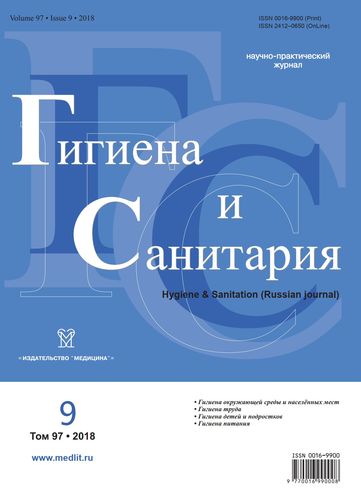The comparative analysis of incidence and mortality of the population living in various climatic zones of Russia
- Authors: Yakovleva T.P.1, Mikhaylova N.S.2, Tikhonova G.I.2, Kalitina M.A.1
-
Affiliations:
- Russian State Social University The Ministry of Education and Science of the Russian Federation
- Federal State Budgetary Institution «Research Institute of Occupational Health» under the Russian Academy of Medical Sciences
- Issue: Vol 97, No 9 (2018)
- Pages: 813-818
- Section: ENVIRONMENTAL HYGIENE
- Published: 20.10.2020
- URL: https://rjsocmed.com/0016-9900/article/view/640428
- DOI: https://doi.org/10.47470/0016-9900-2018-97-9-813-818
- ID: 640428
Cite item
Full Text
Abstract
The article presents a comparative analysis of health indices of the population living in different (second and third) climatic zones of Russia. The selection of the climatic belts is based on the climate of each zone: average January temperature, average July temperature, especially the winter period, which affects the heat transfer processes in a person and the subjective, the perception of comfort climate. In identifying the role of climatic factors in shaping the health of the population, a comparative analysis of areas with different climatic parameters at similar levels of socio-economic indices: per capita income, unemployment rate, number of physicians, persons with higher and incomplete higher education, ethnic composition. Under similar socio-economic conditions in the regions, the role of climate is obviously shown to be in shaping the health of the population. The health of the population was assessed in terms of the morbidity and mortality rate in selected population groups. The morbidity rate was analyzed in age groups, not characteristic for migration (children aged 15-17 years and older). Children not exposed to occupational factors as adult population residing permanently in the region. The incidence of an older population living in the third climatic zone (Novosibirsk region), as in all diseases, and for individual disease groups exceeded the performance of the corresponding age groups of the second climatic zone (Penza region). Higher levels of the mortality rate of the population of the Novosibirsk region, compared to the same figures for the population of the Penza region, are formed at the age of 50 years and older in the following causes of death: cerebrovascular diseases, endocrine diseases, alcoholism, trauma, poisoning, and other external influence.
About the authors
Tatiana P. Yakovleva
Russian State Social University The Ministry of Education and Science of the Russian Federation
Author for correspondence.
Email: yakoff.t@yandex.ru
ORCID iD: 0000-0001-7143-4779
MD, Ph.D., DSci., professor, Department of ecology and technosphere safety of the Russian State Social University, Moscow, 129226, Russian Federation.
e-mail: yakoff.t@yandex.ru
Russian FederationN. S. Mikhaylova
Federal State Budgetary Institution «Research Institute of Occupational Health» under the Russian Academy of Medical Sciences
Email: noemail@neicon.ru
ORCID iD: 0000-0002-7177-6928
Russian Federation
G. I. Tikhonova
Federal State Budgetary Institution «Research Institute of Occupational Health» under the Russian Academy of Medical Sciences
Email: noemail@neicon.ru
ORCID iD: 0000-0002-1948-4450
Russian Federation
M. A. Kalitina
Russian State Social University The Ministry of Education and Science of the Russian Federation
Email: noemail@neicon.ru
ORCID iD: 0000-0002-7967-5857
Russian Federation
References
- Baevskiy R.M. Forecasting of conditions on the verge of a regulation and pathology [Prognozirovanie sostojanij na grani normy i patologii]. Moscow: Meditsina; 1979. (in Russian)
- Borisenkova E.P., Karpenko V.N. Climate and human health. International symposium of WMO, WHO, UNEP [Mezhdunarodnyy simpozium VMO, VOZ, YuNEP]. Leningrad; 1986, September 22-26. (in Russian)
- Ivanova A.E., Zemlyanova E.V., Mikhaylov A.Yu., Golovenkin S.E. Distinctions of mortality of adult population of Russia on education level Zdravoohranenie Rossijskoj Federacii. 2014; 58 (2): 4-8. (in Russian)
- Kaznacheev V.P. Modern aspects of adaptation [Sovremennye aspekty adaptatsii]. Novosibirsk: Novosibirskoe otdelenie izdatel’stva «Nauka»; 1980. (in Russian)
- Environmental health climate environmental exposure risk assessment risk management disease susceptibility health policy public health. [Metody ocenki chuvstvitel’nosti zdorov’ja cheloveka i adaptacii obshhestvennogo zdravoohranenija k izmeneniju klimata]. Kopengagen: VOZ; 2005. (in Russian)
- Nevidimova O.G., Yankovich E.P., Yankovich K.S. Assessment of bioclimatic resources of the central and southern parts of Western Siberia. Nauchnyj zhurnal KubGAU. 2015; 109(05). Available at: http://ej.kubagro.ru/2015/05/pdf/40.pdf (in Russian)
- Revich B.A., Shaposhnikov D.A., Avaliani S.L., Rubinshteyn K.G., Emelina S.V., Shiryaev M.V. i dr. Assessment of health hazard of the population of Moscow of high temperature and pollution of atmospheric air Gigiena i sanitariya. 2015; 1: 36-40. (in Russian)
- Rocheva E.V., Smirnov V.D. About tendencies in change of duration of “heat waves” in the territory of Russia. Problemy ekologicheskogo monitoringa i modelirovaniya ekosistem. 2013; 25: 94-114. (in Russian)
- Rusanov V.I. Complex meteorological indicators and evaluation methods of climate for the medical purposes: Education guidance [Kompleksnye meteorologicheskie pokazateli i metody otsenki klimata dlya meditsinskikh tseley: Uchebnoe posobie]. Tomsk: Izd-vo Tom. un-ta. 1981; 86 s. (in Russian)
- Sedov V.E. About climatic fluctuations and tendencies of climate of modern Moscow Meteorologiya i gidrologiya. 2012; 8: 47–58. (in Russian)
Supplementary files









